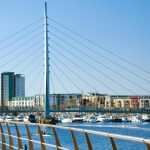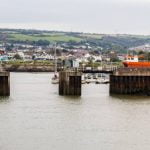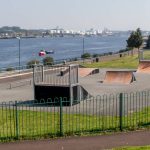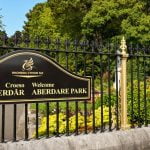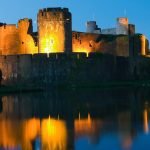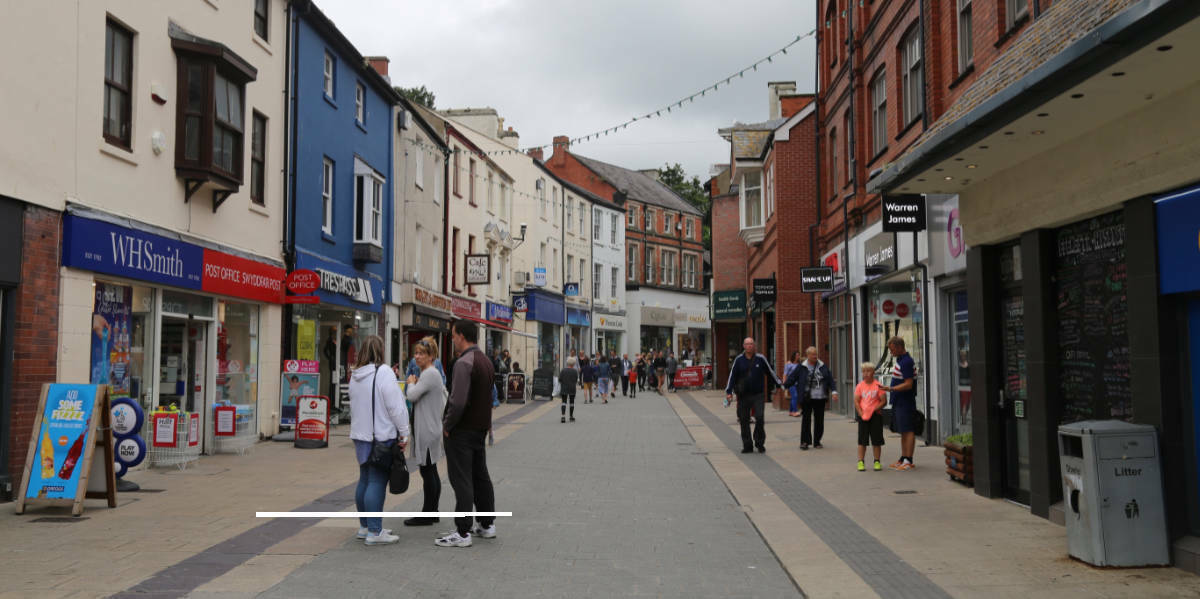
Bangor (Wales) is Wales’ oldest noble city. Not to be confused with Bangor (Northern Ireland) where they keep the boats*.
*We have nothing against boats. In fact, we like boats. We like Bangor in Ireland too. So much in fact, that we already wrote about it. See this article for Bangor in Northern Ireland. However, this one is about the
Bangor is the oldest city in the north of Wales. With a written history we can trace all the way back to the 6th century, it is one of the most continuously occupied stretches of land in all of the UK. Bangor just doesn’t get enough recognition. Home to 20,000 people, this town lies across the water from Anglesey via the Menai Strait. It has its own important port, its own cathedral, and a university as well. It really is scoring highly on the first impressions stakes, isn’t it?
Here’s all you need to know about Bangor in Wales. Is it staycation worthy? We think so. Have a read-on and judge for yourself.
The Early, Early, Early Days of Bangor in Wales
Let us start with a romantic story. Welsh legends circa 1170 say that a prince fell out with his regal family. Owain, Prince of Gwynedd, was royalty in the olden day kingdom of Gwynedd, which occupiers later turned into a county. Owain’s son Madoc ab Owain Gwynedd, took to the sea in his anger, armed only with his favourite brethren and supplies. Westward, of course, there lay Ireland and then a whole load of nothing. Madoc went out into the great nothingness and never returned.
Legend holds that when explorers arrived in the New World hundreds of years later, they found a single tribe of white Indians. Those natives spoke perfect Welsh. Nobody knew why. The tale goes that Madoc and his men landed in the New World, made a life there with the locals, and never went home. Historians believe 20th-century writers falsified the tale to aid New World propaganda. The Brits used the tale to claim that they landed in America first.
Kingdom of Gwynedd
Bangor is the northernmost point of the Kingdom of Gwynedd. These legends are the tales and fables of the oldest city in Northern Wales. Let’s see what else we can dig up from this not-to-be-forgotten kingdom.
Interestingly enough, we can trace the descendants of this king down the line a little. Owain became ‘Owen’ over the years, and the Owen family has thousands of branches to this day. Other names descended from the old kingdom include Bould, Wynnes, and Griffiths. Church records from the medieval period show there were 16 original tribes of North Wales. The Romans recorded 7 tribes total on Ptolemy’s map.
According to them, the Ordovices tribe occupied the land where Bangor stood. According to the church, there were Lloyds, Foulkes, and Hughes on Anglesey across the water from the town. Bangor was an area with many families living in it because it has always been a cathedral city.
The Romans Arrive
After the Romans arrived, they broke Wales up into more manageable chunks. They invaded around the same time as they came over from Europe to England. They tackled southeastern England around AD 40 and came to Wales 7 years later. There is an interesting map that shows the kingdoms before then on the Welsh government’s pages. However, the Romans didn’t invade Anglesey until Ad 60/61.
With Bangor straight across the coast, you can imagine that it suddenly became a hive of activity as the soldiers crossed the river. Of course, the attack halted and turned when Boudica led the Iceni, the Trinovantes, and the other unified tribes in an attack on Colchester’s Roman camp. They burned London next. At that time, London was only 20 years old. Historians believe Boudica’s army killed as many as 80,000 Romans. She did it. That’s what happens when you try to take away a Welsh woman’s inheritance.
So before we even get to the early days, Roman soldiers twice through trampled the town. Let’s skip ahead to after the Romans left or merged and see when Bangor next pops up.
The Dark Ages
The town’s real history starts in the 6th century. In 525AD the first bishop of northern Wales commissioned a monastery here. That bishop became St. Deiniol. The church later consecrated the Bishop of Bangor and gave him an Abbey. The abbey was a cathedral by 558, so he must have been a popular guy.
In 613, the Saxon leader Aelfrith of Northumbria defeated the Welsh forces of Gwynedd and Powys, combined with Mercian forces, in a battle near Chester. Gwynedd soldiers returned home to lick their wounds. The town of Bangor stayed a peaceful settlement which thrives on being just north of the main crossing point to Anglesey. The Menai Suspension Bridge opened in the 18th century to replace the old wooden versions.
Bangor next pops up in the history books in 1120-39, when the new cathedral opened. Archbishop Baldwin came to preach about the Crusade here in 1188. Hopefully, nobody followed him into his madness. In the 1200s, a Dominican Friary opened here. The town got holier, if possible. Those were the friars who wore black robes.
The Plague
In 1349 the black death landed in Wales. While the rUK saw a population decline of 20%, Wales suffered disproportionately in the three waves of plague. Since the plague landed by ship, each port suffered the worst. Historians believe Wales lost 40% of its population. This is what happens when you have Covid-19 without any understanding of modern medicine or hygiene practices. Everyone dies.
Owain Glyndwr, a descendant of the kingdom of Powys, declared himself the Prince of Wales in the early 1400s. The young man had a feud with a neighbour which somehow turned into his rebellion against English rule. Legend has it that when he returned from fighting under Henry IV, he rebelled against the crippling hold English soldiers had on Wales. The English defeated him in 1405 but rebels held onto the cause as late as 1412. We’re not biased here, but the British Empire was an Empire. It’s time to admit that we did some bad things over the years.
Henry VIII closed the friary when he dissolved the monasteries. In 1557, a local legend named Geoffrey Glyn opened a free grammar school named the Friar’s School. Bangor stayed a sleepy fishing town up into the 1700s, but we’ll get to that in a minute.
Fun Facts & Trivia About Gwynedd and Bangor
We love to dig up a bit of obscure trivia and here are our favourite fun facts & trivia titbits…
- The professors at Bangor University have named their research vessel after Prince Madoc and his enduring legends. You can read more about Madoc, or Madog ab Owain Gwynedd, here.
- The Menai Strait is between 200 yards and 2 miles long. At low tide, it is possible to walk between them, with only 18 inches of water in some places. However, you might get stuck in a sandbank and drown – so definitely don’t do it. You’d need your best waders and someone to pull you out, just in case. The coastguard has enough to do. The straits are 18 miles long.
- In 1284, Bangor became part of the historic county of Caernarfonshire after Edward I’s conquering of the Principality of Wales. The county had ten hundred, which were the groups he divided places into to make them easier to rule with feudal lords. It was all a mess. Gwynedd was better.
- It’s not just Ireland and Wales. They reckon there are 20+ cities across the world named Bangor. Of course, the Welsh one is one of the oldest.
We have a lot to cover to catch up on this history, so let’s hurry back. Bangor in Wales is a fascinating place.
18th Century Onwards
In 1718, Bangor became the London-Holyhead and London-Dublin transport link thanks to ferry connections in the Porth. In 1721, Browne Willis reported the town had plenty of inns but only around 70 houses. At the start of the industrial period, the town had a population of about 400 people. The Friar’s School received a refurbishment in 1789 and a road led from the inland quarries to the Port the following year. A local merchant built it to make it easier to transport his cargos of the world-famous Welsh slate.
By 1801, the town’s population had grown to 1,770 people. A steam ferry began running in 1822 between Bangor and Liverpool. Tourists visited for day trips. Thomas Telford’s suspension bridge, completed in 1826, brought further growth. The railway reached the town in 1848 and an extension reached Caernarfon in 1852. Cholera killed three people in the town in 1854. 1862 saw the Normal College open and another cholera outbreak killed 14 people four years later. In 1876, Bangor City FC played their first match. A typhoid epidemic caused trouble in 1881. In 1883 Bangor, EST. 525AD, received its first charter.
The University College opened in 1884. In 1890, the town held its first national Eisteddfod, or annual carnival. In 1894, the University of Wales formed out of Bangor, Cardiff, and Aberystwyth colleges. In 1896 Bangor pier opened as a tourist attraction. There was a ‘Great Strike’ in the Welsh slate quarries in 1900 that brought the industry to a standstill for three whole years. Workers wanted better pay and conditions as the price of the slate they quarried soared. The strike was exclusive to Porth Penrhyn and the Lord of the castle there.
Modern Welsh Bangor
Bangor held the Eisteddfod every few years after its kick-off. They held it in 1902, 03, 15,31,40, and so on. In 1962 the town’s FC won the Welsh Cup. In 1967 the great Yogi Maharishi Mahesh came to lecture at the university. The Beatles were in Bangor when they found out their manager died. In 1972, Bangor FC became a founding member of the Alliance Premier League. In 1992 they joined the League of Wales. In 1996 the University merged with the College Normal. By the beginning of the 2000s, Bangor’s population was 13,725, though it has since swollen to 18k+.
Modern Bangor is bustling and busy. It’s a hub of international activity. Any student town has great nightlife, so city break enthusiasts can come here for a great night out. The town is on the sea, or on the Strait, and has excellent transport links. You can hop here from Liverpool in barely any time at all. Is it staycation worthy? Of course, it is. But let’s review some of the attractions just to be on the safe side.
Famous People From Caernarvonshire
We wouldn’t be effective journalists if we didn’t research the famous people you might meet in Bangor. Many a famous face has graced these streets over the years. Here are some of our favourite famous Bangor faces:
- A number of actors come from Bangor, including Owain Arthur, Ian Whyte, Lee Williams, David Barry, and Ben Roberts.
- Several musicians, including Sasha, Duffy, Endaf Emlyn, and Cian Ciaran.
- Poet Tony Conran and screenwriter Alexandra Boyd.
- Architect Harold Hughes
- News presenter Sian Lloyd
And there’s a lot more than that. Bangor has a lot of famous people in it. Keep an eye out.
Best Attractions in Bangor, Wales
If you have read this far into the article, you are either a local eager to read about your town, or you are a tourist thinking about adding it to your itinerary. In either case, here are the best things you can see and do in Bangor if you are on a city break or holiday to northern Wales.
Historic Sites and Landmarks
One of the best sites locally is Penrhyn Castle. This site has become a museum over the years, dedicated to the torture and slavery that founded it. Slaves built the castle, whom Lord Penrhyn brought back from his trades abroad. Beautiful it may be now, but the landowner who built it quarried Welsh slate on the broken backs of men and women he did not pay well, or sometimes at all. The three-year strike in 1900 happened for a reason.
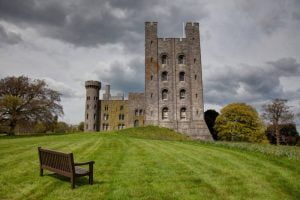
Image Gail Johnson/Shutterstock.com
So it’s pretty, and the architecture is striking – but you cannot help but feel haunted as you enjoy this castle. We recommend that you take a trip out to the quarries too if this is your bag.
Another favourite local landmark is the Bangor Garth Pier. Built by the Victorians, this pier juts out into the Menai Strait on dainty legs that look like it will drop you into the ocean. This grade II listed structure extends 470m out into the strait. It’s both perfectly safe and it was pier of the year 2022. Go and have a look.
Bangor University is neither a gallery nor a museum. It is a historical site and it is a local landmark. The old buildings have been in place for hundreds of years, producing high-quality students that have gone on to power Wales and the UK in general. Go along and take some pictures that make you look smart or take a short course. Why not? You might find you like it here.
Galleries and Museums
There are three galleries you can visit in the city centre of Bangor. Check out the Gallery House or the Bangor Arts Initiative, where you can buy pieces to take away with you. If you’d like an exhibition space, go to the Friends of Gwynedd Museum and Gallery in the town centre. This place has a friendly learning environment and a little café. They rebranded as Storiel in a past life.
If you like bridges you can head across the suspension bridge to the Menai Heritage – Menai Bridges Museum. Here you can learn about the building of the bridges across the Menai Strait. They celebrate the Menai Suspension Bridge, built by Thomas Telford, and the Britannia Bridge, built by Robert Stephenson. Without these bridges, Anglesey would have continued as a sleepy settlement with little outside trade and a dangerous shore. Fun fact: the Romans called Anglesey ‘Mena,’ which is where we get the name of the Strait from.
If you have the transport, hop across the Strait, and visit the Beaumaris Gaol. It was built in the 1800s, this building houses chains, manacles, torture devices, and other fun artefacts. Meant to give you an insight into the life of a prisoner here, the gaol is another example of how history can be haunting if you stop and think about it too long.
You should also check out Heroes Arch which was built in 1923 to commemorate the fallen of WW1. A sombre reminder of the horrors of war.
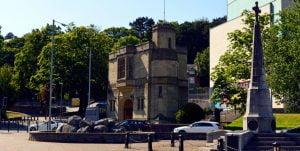
Image: Lachlan1/Shutterstock.com
Outdoor Attractions
The Cwm Idwal National Nature Reserve is right on the doorstep of Bangor. This picturesque national park has gorgeous craggy mountains, lakes and rivers, woodlands, and meadows to enjoy. This is hiking country, the kind of territory you visit to get lost in. This nature reserve sits on the edge of the Snowdonia National Park. This reserve became the first national nature reserve in Wales in 1954, so give it the respect it deserves.
Let’s not forget about Bangor Cathedral, either. Part local landmark, part outdoor attraction, part religious experience, you can go and see the historic Bangor Cathedral for yourself. Cadeirlan Bangor falls under the rule of the diocese of Bangor and it is gorgeous. Take nice Instagram pics or attend a service in this fully functioning cathedral. They speak a lot of Welsh here, just so that you are prepared.
Famous the world over, you can follow the Ogwen Trail from southern Wales all the way up north to Bangor and onwards into Anglesey. Enjoy the stunning views of Wales on this hiking or cycling path. We recommend you take your bike because it’s a long one.
Sports and Recreation
Bangor City FC earned the nickname The Citizens. You can find them at the Nantporth Stadium in town. They have been around since 1876 and have a long history of success including playing in Europe on many occasions. They have a 3000-seater stadium so you can usually catch a match without having to book in advance.
There is also a Bangor RFC if you prefer rugby.
The local golf club is Bangor St. Deiniol Golf Club which is one of North Wales’ premier courses. It was formed in 1906 and it offers some stunning views of Anglesey & Snowdonia. It’s quite a challenging course so may not be ideal for beginners. Mind you on a clear day the views make up for the lost golf balls.
Shopping and Retail
There are loads of shops in Bangor city. Since the tourist trade rose up here, the shops followed. You can find all you need in the Deiniol Shopping Centre or go big with the Menai Shopping Centre. There is also the Menai Retail Park on the outskirts of town.
Other Notable Attractions
If you are sticking around or moving to the area, there are other places of interest to see. All the better if you have transport and you can get out into the countryside. Here are some of the other sights we recommend in this region of Wales:
- Visit either of the two bridges
- Walk the scenic path to Bethesda and see the church there
- Visit Bangor swimming pool, which has an outdoor vibe
- Head out to Spinnies Aberogwen Nature Reserve
- Enjoy the peace and tranquillity found in the Bible Garden
- Go to the Pontio theatre and see a show
- Enjoy hiking, biking, and even zip sliding, in Snowdonia National Park
There are loads to do in Bangor so get out there and have a blast.
How to Get to Bangor?
At this point in the tour, we always try our best to give you directions. Take our advice and use your sat nav, it’s safer for everyone.
By Road
Follow the M6 north out of Birmingham or south out of Liverpool. Head west on the A55.
By Rail
You need Bangor (Gwynedd) train station.
By Air
Your nearest airport is in England at John Lennon in Liverpool.
By Sea
Head for Porth Penrhyn to anchor.
…Just 5 More Minutes…
Still looking for entertainment? We have a whole section on that over at Five Minutes Spare HQ. Take a look for yourself or show your appreciation of our terrific wit by dropping us a follow on Facebook. All the cool kids are doing it.
Header Image: Wozzie/Shutterstock.com

